It’s grammar time! This month we will tackle the terrible and feared subjunctive! If you are familiar with Italian grammar, you probably know that Italian has some tenses that English does not have anymore. One of these tenses is congiuntivo, subjunctive. But how is it formed? When do you use it? Fear not, I am here to make it as clear to you as I can. What are you waiting for? Get a pen and a paper and let’s dive right into it!
First of all, there are four types of congiuntivo: presente, passato, imperfetto, and trapassato. Two simple tenses and two that require an auxiliary. Today, we will only see the congiuntivo presente. We must take one step at a time; Rome wasn’t built in a day after all. As it is always the case in Italian, the verb conjugation depends on the ending of the verbs. If the verb ends in -are, like in parlare, to speak, the endings are the following: (che) io parl-i, (che) tu parl-i, (che) lui/lei parl-i, (che) noi parl-iamo, (che) voi parl-iate, (che) loro parl-ino. If the verb ends in -ere, as in vedere, to sell, the endings are the following: (che) io ved-a, (che) tu ved-a, (che) lui/lei ved-a, (che) noi ved-iamo, (che) voi ved-iate, (che) loro ved-ano. If the verb ends in -ire, like in dormire, to sleep, the endings are the sa me as in the –ere endings. There are three important things to notice. The first one is that io, tu, lui/lei have the same ending. The second one is that noi at the congiuntivo presente is the same exact form as in indicative presente. And the third one is that usually congiuntivo is introduced by the conjunction che, “that.”
But when do we use it? First of all, congiuntivo presente indicates a possibility, a desire, or a prediction in the future and it is used in a subordinate sentence that depends on a sentence with a present or future verb of the indicativo. For example: Penso che Luca lavori a Milano, “I think (that) Luca works in Milan.” The verb in the main sentence in this case is at the presente indicativo, “penso,” so the verb in the second and subordinate sentence is at congiuntivo, “lavori,” because I am not sure whether he work in Milan or not, it is a guess, it’s likely, but I am not sure. One important thing is that, in order to use the subjunctive, the subjects of the two sentences must be different; in the example, the subject of the first sentence is “I” while in the second sentence is “Luca.”
The trick to understand whether I need to use the subjunctive or not is understanding whether what I am about to say is a guess of mine, something I think or believe, something I wish, or something I am not sure about. And understanding it, it is actually easier than what you may think. How? Well, you simply state it! Any time you start your sentence with, “I think (that),” “I believe (that),” “I suppose (that),” “I guess (that),” “I doubt (that),” “ I wish (that),” or even “I am not sure (that),” “I am afraid (that),” “It is possible/impossible (that),” and so on, you must use congiuntivo.
Subjunctive is also mandatory after certain linkers. Let’s take a look at some of them. Prima che, “before,”or dopo che, “after” as in: Sparecchiamo prima che/dopo che arrivi – Let’s clear the table before/after she arrives. Or qualsiasi, qualunque, chiunque, dovunque – whatever, whoever, wherever – as in: chiunque esso sia, ha una voce bellissima – Whoever he is, he has a great voice. Nonostante – despite: Nonostante piova, vanno in spiaggia – Despite it’s raining, they go to the beach. A condizione che or a patto che – as long as: Vengo, a patto che tu porti la palla – I’ll come, as long as you bring the ball. Or even a meno che – unless: A meno che piova, faremo un pic-nic – unless it rains, we’ll have a pic nic.
You can also find the congiuntivo presente in independent sentences, like exclamations, especially when expressing doubt, a wish, or giving a formal permission or an order. So let’s see a few example to make it a little more clear. We said a doubt: Che sia via? Meaning “Could he/she be out?” or Che sia un nuovo professore? – “Could he be a new professor?” A wish: Che tu abbia uno splendido compleanno – “May you have a wonderful birthday.” A formal permission: Si accomodi – “Please, come in” – or even Venga pure – “Please, come.” And a formal order: “Stia attento!” – Be careful! Remember that when I am saying “formal,” you must use the lei form.
I know it seems quite a lot, but trust me that when you start using it, little by little, it will become natural and easy. If you are doubting, thinking, guessing, it is always congiuntivo. And if you mess up? Well, if I were you, I wouldn’t worry too much; even Italians find subjunctive difficult to use. Follow my rules and you might even be able to catch them making a few mistakes!



